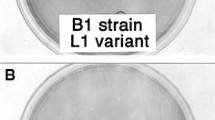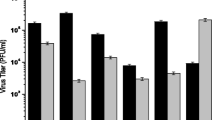Summary
The effect of polyionic compounds on the plating efficiency of some strains of vesicular stomatitis virus (VSV) was studied in BHK-21, C-13 cells. Plaques produced by VSV Indiana1 and Indiana2 showed similar morphological characteristics, while small differences in size were encountered.
The effect of polyionic compounds on the size of plaques produced by VSV New Jersey, Indiana1 and Indiana2 was not significant.
VSV Indiana3 produced plaques with a morphology and size (irregular edges and minute) completely different from the other VSV studied. Its plaque forming ability was completely inhibited when 100 [Μg/ml of dextran sulfate were added, and significantly enhanced when the same concentration of DEAE-dextran was used.
Similar content being viewed by others
References
Cottral, G. E., R. E. Patty, P. Gailiunas, andF. W. Scott: Relationship of foot-and-mouth disease virus plaque size on cell cultures to infectivity for cattle by intramuscular inoculation. Arch. ges. Virusforsch.18, 276–293 (1966).
Crandell, R. A., andI. Gomes: Plaque morphology of some South American strains of foot-and-mouth disease virus and the effects of polyionic compounds on plaque formation. Arch. ges. Virusforsch.30, 137–146 (1970).
Dinter, Z., L. Philipson, andT. Wesslén: Properties of foot-and-mouth disease virus in tissue culture. I. Changes in plaque morphology and antigenicity following passage in tissue culture. Arch. ges. Virusforsch.9, 411–427 (1959).
Earley, E., P. H. Peralta, andK. M. Johnson: A plaque neutralization method for arboviruses. Proc. Soc. exp. Biol. (N.Y.)125, 741–747 (1967).
Federer, K. E., R. Burrows, andJ. B. Brooksby: Vesicular stomatitis virus. The relationship between some strains of the Indiana serotype. Res. Vet. Sci.8, 103–117 (1967).
Jonkers, A. H., R. E. Shope, T. H. G. Aitken, andL. Spence: Cocal virus, a new agent in Trinidad related to vesicular stomatitis virus, type Indiana. Amer. J. vet. Res.25, 236–242 (1964).
McPherson, I., andM. Stoker: Polyoma transformation of hamster cell clones — an investigation of genetic factors affecting cell competence. Virology16, 147–151 (1962).
Sellers, R. F., L. M. Burt, A. Cumming, andD. L. Stewart: The behavior of strains of the virus of foot-and-mouth disease in pig, calf, ox, and lamb kidney tissue cultures. Arch. ges. Virusforsch.9, 637–646 (1959).
Tilles, J. G.: Enhancement of vesicular stomatitis virus following adsorption with Poly-L-ornithine. Proc. Soc. exp. Biol. (N.Y.)131, 76–81 (1969).
Takemoto, K. K., andH. Liebhaber: Virus-Polysaccharide interactions. II. Enhancement of plaque formation and the detection of variants of poliovirus with dextran sulfate. Virology17, 499–501 (1962).
Vaheri, A.: Heparin and related polyionic substances as virus inhibitors. Acta path. microbiol. scand.171 (Suppl.) (1964).
Author information
Authors and Affiliations
Rights and permissions
About this article
Cite this article
Gomes, I., Vieira, A. Effect of polyionic compounds on the plating efficiency of some strains of vesicular stomatitis virus. Archiv f Virusforschung 34, 223–231 (1971). https://doi.org/10.1007/BF01242996
Received:
Issue Date:
DOI: https://doi.org/10.1007/BF01242996




